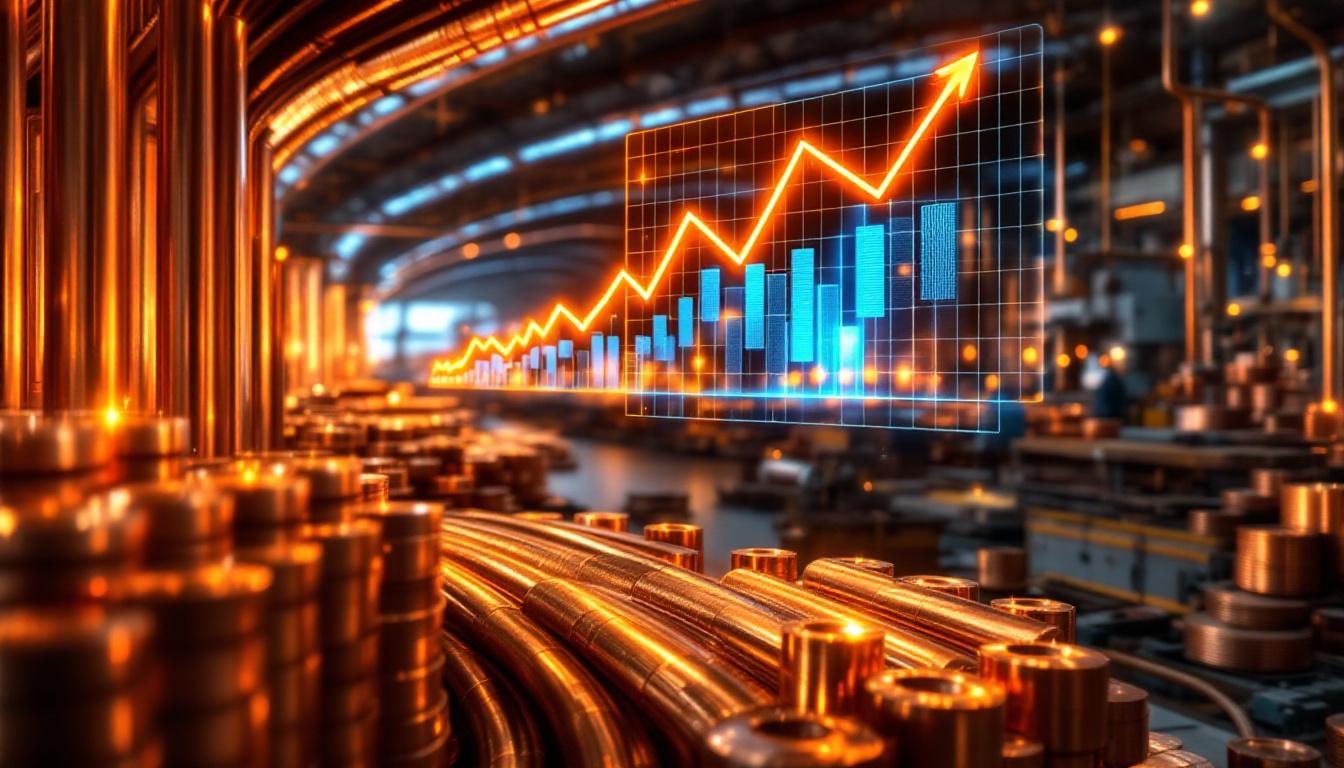What Caused the Surge in Unlisted Rare Earth Oxide Imports in May 2025?
The rare earth market witnessed a significant spike in unlisted rare earth oxide imports during May 2025, with volumes reaching approximately 9,076.4 metric tons. This represents a substantial 67% year-over-year increase and a notable 39% month-over-month growth from April 2025. Despite this surge, the January-May 2025 cumulative imports of 21,925.6 metric tons still show an 8% year-over-year decrease compared to the same period in 2024.
Industry analysts at Shanghai Metal Market (SMM) attribute this unexpected rush shipment and surge in unlisted rare earth oxide imports in May to weather-related factors in Myanmar, one of China's key suppliers of rare earth materials.
The May 2025 Import Spike Explained
The May 2025 surge in unlisted rare earth oxide imports can be attributed to several key factors:
- Inventory backlog: During the initial recovery period of Myanmar's mines in April 2025, a significant amount of local inventory accumulated, creating pressure for rapid transportation.
- Seasonal timing: The surge coincided with the approaching rainy season that typically begins at the transition between Q2 and Q3.
- Year-over-year growth: The 67% YoY increase for May represents one of the largest single-month jumps in recent years.
- Volume significance: The 9,076.4 metric tons imported in May account for over 41% of the entire January-May 2025 import total.
This pattern reflects a combination of supply chain logistics and seasonal environmental factors rather than a fundamental shift in demand.
Myanmar's Weather-Driven Export Rush
The primary driver behind the May 2025 import surge was a strategic move by miners in Myanmar to expedite shipments before the onset of the annual rainy season:
- Pre-monsoon logistics: Miners rushed accumulated inventory to China before monsoon rains could compromise transportation routes.
- Ion-adsorption ore vulnerability: The clay-like composition of Myanmar's ion-adsorption rare earth ores makes extraction and transportation particularly sensitive to precipitation.
- Road infrastructure limitations: Myanmar's mining regions lack all-weather roads, making transportation during rainy seasons extremely difficult or impossible.
- Seasonal pattern predictability: Industry veterans note this rush shipment and surge in unlisted rare earth oxide imports in May occurs annually, though 2025's surge was particularly pronounced due to higher inventory levels.
"During the initial recovery period of Myanmar's mines in April, there was a significant amount of local inventory ore," reported SMM analysts after consulting with miners in the region. "As the end of Q2 and beginning of Q3 mark the rainy season, miners expedited transportation in April-May to avoid weather disruptions."
According to regional weather experts, the 2025 monsoon season was forecasted to arrive earlier than usual, further accelerating the rush shipment timeline. This seasonal push to beat weather challenges created the temporary but significant spike in import volumes.
Industry analysts predict that import volumes will naturally decline in June-July 2025 as the rainy season takes hold, creating a predictable valley following May's peak.
How Are Overall Rare Earth Metal Ore Imports Trending in 2025?
While unlisted rare earth oxide imports saw a significant surge in May 2025, the broader picture for rare earth metal ore imports shows a continuing downward trend, reflecting deeper structural changes in global supply chains.
January-May 2025 Import Overview
The general trend for rare earth metal ore imports presents a stark contrast to the surge in unlisted rare earth oxides:
- Total imports decline: Rare earth metal ore imports reached only 18,737 metric tons from January to May 2025, representing a substantial 23% year-over-year decrease.
- May imports collapse: May 2025 imports fell dramatically to just 1,122 metric tons.
- Sequential decline: This May figure shows a steep 70% decrease from April 2025 levels.
- Year-over-year plunge: Compared to May 2024, imports have fallen by a staggering 81%.
- Contrasting patterns: The simultaneous surge in unlisted rare earth oxides and collapse in rare earth metal ores highlights the divergent supply dynamics at play.
These figures suggest a fundamental restructuring of supply chains rather than simply temporary fluctuations due to seasonal factors.
MP Materials Export Suspension Impact
A major factor driving the decline in rare earth metal ore imports has been the suspension of exports from a key U.S. supplier:
- Supply chain disruption: MP Materials suspended rare earth concentrate exports to China since April 2025.
- Tariff dispute origins: The initial suspension was triggered by unresolved tariff issues between the U.S. and China.
- Persistent alteration: Despite subsequent alleviation of some tariff concerns, the established export patterns remain disrupted.
- Strategic response: The suspension represents part of broader global adjustments to China's rare earth export controls.
- Predicted decline: Industry analysts had anticipated this significant drop in U.S.-sourced imports, reflecting structural rather than cyclical changes.
The suspension of MP Materials' exports highlights how the US–China trade war impact is reshaping traditional rare earth supply chains. As one industry expert noted, "Even after tariff issues were partially resolved, the trade flow patterns had already begun shifting toward more regionalized supply chains, a trend that's likely to continue through 2025 and beyond."
How Is the Global Rare Earth Supply Chain Evolving?
The contrasting trends in different categories of rare earth imports reflect deeper changes in the global rare earth supply chain, with significant implications for future market dynamics.
Strategic Shifts in Rare Earth Sourcing
The global rare earth supply chain is undergoing fundamental transformation:
- Accelerated domestic development: Countries are rapidly building domestic rare earth processing capabilities to reduce dependence on traditional supply chains.
- U.S. and Australian leadership: The United States and Australia are at the forefront of efforts to develop self-sufficient rare earth value chains.
- Export control influence: China's export controls on rare earth materials have served as a catalyst for international supply chain restructuring.
- Adjusted expectations: Industry players are recalibrating long-held assumptions about traditional import patterns and dependencies.
- Value chain localization: The trend toward more regionalized processing capacity represents a structural shift away from globalized supply chains.
These changes suggest a long-term reconfiguration of global rare earth flows rather than temporary adjustments to seasonal or short-term market conditions.
Market Implications and Future Outlook
The evolving global supply chain has several important implications for market participants:
- Temporary surge context: The May 2025 surge in unlisted rare earth oxide imports should be understood as a weather-driven anomaly rather than a reversal of the broader trend toward reduced imports.
- Predictable seasonal patterns: The rush shipment phenomenon from Myanmar creates a forecasting challenge, but one that follows established seasonal rhythms.
- Geopolitical influence persistence: Trade tensions, export controls, and strategic mineral policies will continue to shape trade flows throughout 2025 and beyond.
- Supplier diversification: New supplier relationships are likely to emerge as the market adjusts to changing trade patterns.
- Regulatory adaptation: Industry participants must navigate an increasingly complex regulatory landscape as countries implement policies to secure rare earth supply chains.
As one market analyst observed, "The rush shipment and surge in unlisted rare earth oxide imports in May represents a temporary logistical response to weather conditions, not a fundamental shift in demand or supply capacity. The long-term trend toward more diversified and regionalized supply chains remains firmly in place."
FAQ About Rare Earth Import Trends
Why did unlisted rare earth oxide imports surge specifically in May 2025?
Miners in Myanmar rushed to transport accumulated inventory before the rainy season (typically beginning at the Q2-Q3 transition) could hamper transportation routes and logistics, creating a temporary but significant spike in import volumes. The substantial inventory buildup during the recovery period of Myanmar's mines in April 2025 amplified this seasonal rush shipment phenomenon, resulting in the 67% year-over-year increase for May.
What factors are causing the overall decline in rare earth metal ore imports?
The 23% year-over-year decline in rare earth metal ore imports from January to May 2025 stems from multiple factors, including MP Materials' export suspension to China since April 2025 due to tariff issues, and strategic shifts as countries like the US and Australia develop domestic rare earth processing capabilities. This represents a structural change in global supply chains rather than a temporary fluctuation, with geopolitical tensions and Trump's critical minerals order playing significant roles in reshaping traditional trade flows.
How might these import trends affect rare earth prices?
While the data doesn't directly address pricing, the combination of declining overall imports with temporary surges creates market volatility. The rush shipment from Myanmar before seasonal challenges suggests suppliers anticipate potential supply constraints, which typically exerts upward pressure on prices. Meanwhile, the development of alternative supply chains may moderate price impacts in the longer term as new processing capacity comes online in countries seeking to reduce dependence on traditional suppliers.
What are unlisted rare earth oxides and why are they tracked separately?
Unlisted rare earth oxides refer to rare earth compounds that don't fall under specific customs classification codes. They're tracked separately because they often represent different processing stages or compositions than standard rare earth metal ores, providing additional insight into supply chain dynamics. These unlisted categories typically include mixed rare earth concentrates and intermediate products that haven't been fully separated into individual rare earth elements, making them valuable indicators of overall market activity and processing capacity.
Comparing Rare Earth Import Sources and Trends
| Import Category | Jan-May 2025 Volume | YoY Change | May 2025 Volume | MoM Change | YoY Change (May) |
|---|---|---|---|---|---|
| Rare Earth Metal Ores | 18,737 mt | -23% | 1,122 mt | -70% | -81% |
| Unlisted Rare Earth Oxides | 21,925.6 mt | -8% | 9,076.4 mt | +39% | +67% |
Key Market Insight: The contrasting trends between rare earth metal ores and unlisted rare earth oxides highlight the complex dynamics in the rare earth supply chain. While overall imports are declining, specific categories show significant volatility influenced by seasonal, geopolitical, and strategic factors.
The Significance of Myanmar in China's Rare Earth Supply Chain
Myanmar has emerged as a critical link in China's rare earth supply chain, with its significance highlighted by the May 2025 import surge. Understanding Myanmar's role provides important context for interpreting current and future market trends.
Myanmar's Strategic Position
Myanmar occupies a unique position in the rare earth supply ecosystem:
- Ion-adsorption rare earth deposits: Myanmar is one of the world's primary sources of ion-adsorption rare earth ores, which are particularly valuable for their high concentration of heavy rare earth elements.
- Heavy rare earth specialization: Myanmar's deposits are especially rich in dysprosium, terbium, and other heavy rare earths essential for high-tech applications.
- Geographical advantage: Myanmar's proximity to China creates natural logistical advantages compared to more distant suppliers.
- Weather vulnerability: The country's tropical monsoon climate creates predictable but significant seasonal supply challenges.
- Border trade infrastructure: The flow of rare earths from Myanmar to China relies heavily on cross-border trade routes that are sensitive to both weather and policy changes.
These factors combine to make Myanmar an irreplaceable but sometimes unpredictable source of critical rare earth materials. The global rare earth reserves distribution further highlights Myanmar's strategic importance in the supply chain.
Transportation Challenges and Solutions
The rush shipment phenomenon observed in May 2025 highlights the complex logistics challenges in the Myanmar-China rare earth trade:
- Seasonal disruptions: The annual rainy season creates a predictable window of transportation difficulties from June through September.
- Adaptation strategies: Miners have developed sophisticated inventory management approaches to mitigate weather impacts, including the pre-rainy season rush shipment seen in May 2025.
- Infrastructure limitations: Limited road development in mining regions means even moderate rainfall can render transportation routes impassable.
- Inventory stockpiling: The pattern of accelerated shipments before the rainy season creates cyclical inventory buildups in China.
- Supply chain planning: Processors and end-users increasingly factor these seasonal patterns into their procurement strategies.
As one mining operator in the region explained, "When the rains come, everything stops. Roads become impassable, and moving ore becomes nearly impossible. That's why we push so hard in April and May to move everything we can."
How Global Rare Earth Development Affects Import Patterns
The evolution of rare earth processing capabilities outside traditional centers is reshaping global trade flows, with significant implications for China's import patterns.
International Rare Earth Industry Development
Countries around the world are investing heavily in domestic rare earth capabilities:
- Processing capacity expansion: Nations are building new processing facilities to convert raw ores into value-added products closer to the point of extraction.
- Supply chain localization: Governments are implementing policies to encourage domestic processing of rare earth materials.
- Technological investment: Significant research funding is flowing into more efficient and environmentally sustainable rare earth processing methods.
- Strategic partnerships: New international collaborations are forming to create more resilient supply chains outside traditional channels.
- Vertical integration: Mining companies are increasingly investing in downstream processing capabilities to capture more value.
These developments suggest that the changing import patterns observed in early 2025 represent the beginning of a longer-term structural shift rather than a temporary anomaly. Furthermore, the energy transition dynamics are accelerating the demand for rare earth elements in clean energy technologies.
Regulatory and Policy Influences
Government policies are playing an increasingly important role in shaping rare earth trade flows:
- Export controls: China's rare earth export restrictions have accelerated supply chain diversification efforts globally.
- Tariff impacts: As demonstrated by the MP Materials case, tariff disputes can rapidly disrupt established trade patterns.
- Strategic minerals designation: Countries are increasingly classifying rare earths as strategic resources subject to special regulatory treatment.
- Environmental regulations: Stricter environmental standards are influencing where and how rare earths are processed.
- Investment incentives: Government subsidies and tax benefits are encouraging domestic rare earth industry development in multiple countries.
The combination of these regulatory factors with market-driven changes suggests that rare earth trade patterns will continue to evolve throughout 2025 and beyond, with potentially far-reaching implications for global supply chains and price dynamics. The establishment of the European CRM facility represents one significant development in this evolving landscape.
Further Exploration:
Readers interested in learning more about rare earth market dynamics can also explore related educational content, such as China's recent rare earth export surge and Australian rare earth oxide production forecasts that provide additional perspectives on rare earth supply chains and market trends.
Want to Profit from the Next Major Mineral Discovery?
Discover how significant ASX mineral discoveries can generate substantial returns by exploring Discovery Alert's proprietary Discovery IQ model, which transforms complex geological data into actionable investment insights. Visit the Discovery Alert discoveries page to understand historical examples and start your 30-day free trial to position yourself ahead of the market.




